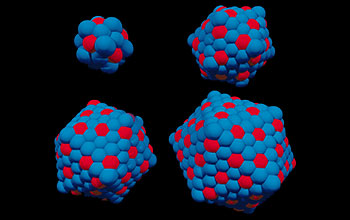Multimedia Gallery
Faceting ionic shells into icosahedra via electrostatic (Image 2)
These simulated shapes are constructed from dozens of charged, closely packed particles, models that are helping researchers better understand how some viruses are constructed and guiding the design of new materials. The research, from the laboratory of Monica Olvera de la Cruz of Northwestern University, shows how one might create icosahedral (20-sided) shapes that lack icosahedral symmetry, a property that could ease the construction of self-assembling, complex molecules. In this image, red balls have an ionic charge of +3, while blue balls have a charge of -1. The interaction of the charges effects the smoothness of the shape, with the number of balls being 32 in the upper left object, following clockwise to 132, 212 and finally 312 in the largest. [See related image Here.]
More about this image
This research was supported by the National Science Foundation (grants EEC 06-47560 and DMR 04-14446).
To learn more, see the Proceedings of the National Academy of Sciences story Mutant chronicles--the quest for a better red-fluorescent protein. (Date image taken: 2007; date originally posted to NSF Multimedia Gallery: May 30, 2018)
Credit: G. Vernizzi and M. Olvera de la Cruz, "Faceting ionic shells into icosahedra via electrostatics," Proc. Natl. Acad. Sci. USA, 104 (47) 18382-86 (2007) DOI: 10.1073/pnas.0703431104
Images and other media in the National Science Foundation Multimedia Gallery are available for use in print and electronic material by NSF employees, members of the media, university staff, teachers and the general public. All media in the gallery are intended for personal, educational and nonprofit/non-commercial use only.
Images credited to the National Science Foundation, a federal agency, are in the public domain. The images were created by employees of the United States Government as part of their official duties or prepared by contractors as "works for hire" for NSF. You may freely use NSF-credited images and, at your discretion, credit NSF with a "Courtesy: National Science Foundation" notation.
Additional information about general usage can be found in Conditions.
Also Available:
Download the high-resolution JPG version of the image. (533.1 KB)
Use your mouse to right-click (Mac users may need to Ctrl-click) the link above and choose the option that will save the file or target to your computer.

